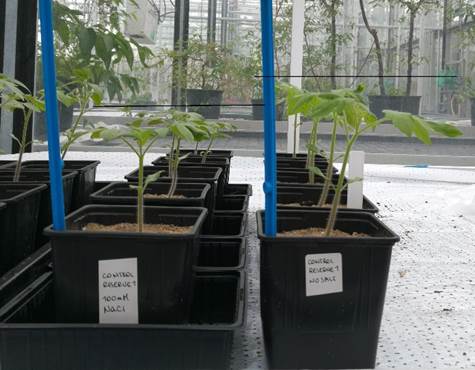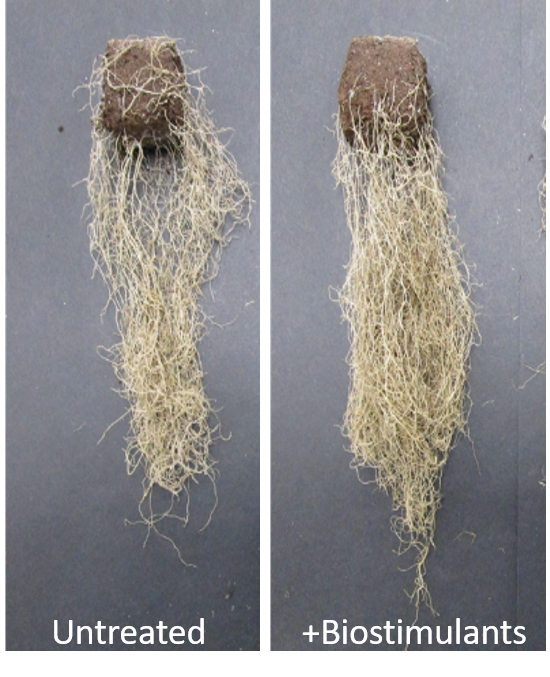Resilience to salinity in tomato

Source: Christa Testerink
Agriculture will have to feed an increasing world population, using a decreasing arable land surface. This is all the more challenging, since the quality of some of our best soils is under threat. Salinity is an increasing problem, in particular in coastal or irrigated areas. Due to climate change, these traditionally fertile areas suffer from increases in soil salinity, reaching concentrations higher than tolerated by current cultivation practices. In the near future these areas will no longer be suitable for cultivating food unless we adopt novel production practices, including the use of novel resilient plant varieties and/or treating plants with natural agents that make them more resilient.
For plants to be resilient to abiotic stresses like salinity and drought, the root system is of vital importance. Roots are the primary organs that adapt their architecture and physiology to drought and salt stress. Their performance is key to the ability of the whole plant to recruit nutrients and water. However, we have limited knowledge of how the root functions and this translates into a limited capability to control plant resilience to abiotic stress.

Source: Christa Testerink
In recent years we have started to discover the role and importance of root architecture, stress QTLs and the interaction of plant roots with mycorrhiza. Novel developments in biostimulants show that it is possible to affect root functioning and resilience towards abiotic stress such as high-salinity. However, despite the potential for agriculture, there is very limited knowledge on the mechanisms through which biostimulants act.
The goal of ROOT is firstly to provide fundamental knowledge on how to improve the resilience of crop root systems towards salinity stress. We will focus on tomato because it is an important field crop in European areas threatened by salinization, and it has many well-organized resources (well-annotated genome, genetic resources).
Key aspects to be addressed by ROOT:
Secondly, ROOT will provide practical knowledge on strategies for reinforcing tomato resilience towards abiotic stress, and go from the lab to the field. ROOT will contribute to developing future cultivation systems for tomato in areas threatened by salinization. The biostimulants that we work with in ROOT will contribute to tomato resilience in the short term, and will create novel opportunities for farmers to operate in areas which are under threat of salinity. The QTLs and markers for root adaptability to salt stress discovered in ROOT will contribute to more resilient tomato varieties in the longer term.
We unite the complementary know-how and expertise of European research groups from four different countries to develop strategies for resilient and salt-tolerant root systems in tomato. The industrial partners in ROOT will not only advise the research project from their market-oriented viewpoint, but will also actively participate in work packages, will perform a field experiment, provide their network for stakeholder involvement and will take the lead in the transfer of knowledge into application.

Source: Christa Testerink
Prof Christa Testerink
Wageningen University, Laboratory of Plant Physiology, NETHERLANDS
Email: christa.testerink@wur.nl
Prof Cinzia Bertea
Università degli Studi di Torino, Department of Life Sciences and Systems Biology, ITALY
Prof Björn Usadel
RWTH Aachen University, Institute for Biology I/Bontany, GERMANY
Dr Rebecca Stevens
INRA, Institut National de la Recherche Agronomique, Research Unit GAFL : Genetics and Breeding of Fruit and Vegetables, FRANCE
Dr Valeria Contartese
Green HAS Italia SpA, ITALY
Dr Shai KOUSSEVITZKY
Hazera Seeds Ltd., Israel
2021
Campobenedetto, C., Mannino, G., Beekwilder, J., Contartese, V., Karlova, R., and Bertea, C. M. (2021).
The application of a biostimulant based on tannins affects root architecture and improves
tolerance to salinity in tomato plants. Scientific Reports, 11 (1), 354.
Gandullo, J., Ahmad, S., Darwish, E., Karlova, R., and Testerink, C. (2021). Phenotyping Tomato Root
Developmental Plasticity in Response to Salinity in Soil Rhizotrons. Plant Phenomics, 6, 1-14.
Karlova, R., Boer, D., Hayes, S., and Testerink, C. (2021). Root plasticity under abiotic stress. Plant
Physiology 187 (3), 1057-1070.